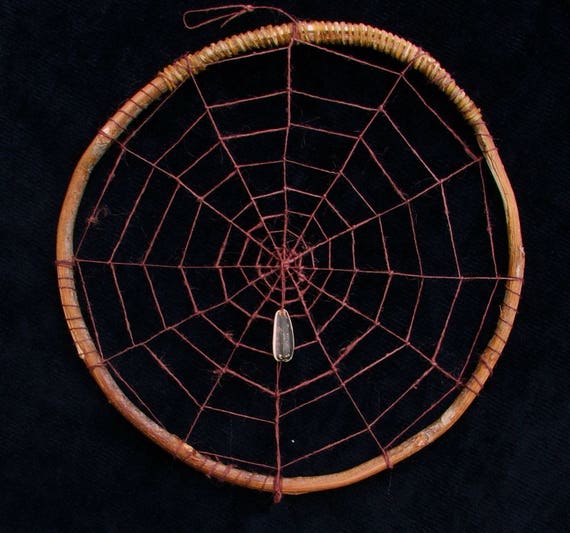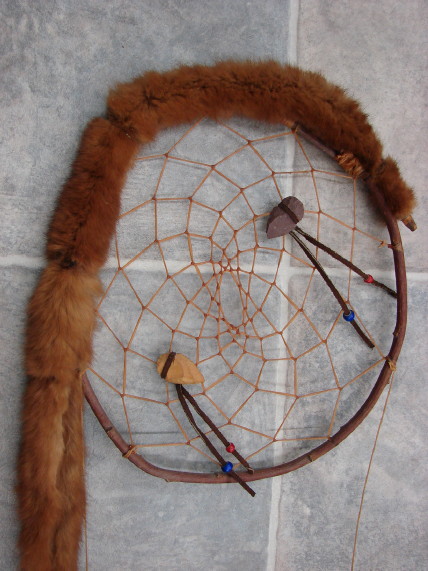Authentic Ojibwe Dream Catcher

gwekwe`!
This weeks post focuses on something I love: dream catchers. I do not know what cultural feature to label this as. Would it be arts and crafts? Superstition or beliefs? Whatever it is, we are going to take a deeper look into the culture and discover the significance and symbolic meaning behind the item in context of Native American culture. Let’s explore a little bit of the history behind the dream catcher in Native American culture.
Handcrafted by Northern Minnesota White Earth Ojibwe Indians (the original makers of a DreamCatcher), is this twig and sinew dream catcher with prayer feather and seed bead spider. Each is one of a kind, Authentic and guaranteed to be original. Measure between 2 1/2″ to 3″ in diameter. Styles will of course vary – colored. Baby and Navy Blue Authentic Cherokee Dream Catcher - 2 Dangles. Baby and Navy Blue Tribal Authentic Cherokee Dream Catcher. Baby Blue and Honey Drop Authentic Cherokee Dream Catcher. Baby Blue and White Authentic Cherokee Dream Catcher. BABY BLUE and WHITE Mini Head Dress (WITH) Back Feathers.
History:
The dream catcher is considered to be a traditional Native American item that originated from the Ojibwe (Chippewa) tribe. For those who do not know, the Ojibwe tribe is from Minnesota, like me! The original version of the dream catcher was not always as fancy and elaborate as they are today. In the past, Native Americans constructed dream catchers from the bones and tissue of animals, also called sinew, and wrapped them in a web around a small frame. In fact, the native word for dream catcher, asabikeshiinh, actually means “spider” specifically because of the web-like design. They were also decorated beautifully with sacred items, and were usually handcrafted using only natural materials. Also, another feature of authentic dream catchers is that they typically only measure a few inches long.
Authentic Ojibwe Dream Catchers

According to Ojibwe legend about dreamcatchers, it is believed that each carefully woven web will catch your dreams in the night air. The bad spirit dreams will become entangled in the web and disappear on the breeze of the new day. A dream catcher is usually placed over a place you would sleep where the morning light can hit it. As you sleep all dreams from the spirit world have to pass through the dream catcher. Only good dreams can pass through to the dreamer while the bad dreams are caught in the webbing and are destroyed by the first rays of the morning light.
I included a picture I found on the internet of what a traditional dream catcher may look like. This may seem different from what you are used to seeing for a number of reasons. First, the shape of the frame is unique. Not only that, but it is composed of a bundle of what appear to be sticks. If you look closely at the image it becomes evident that the webbing inside is not typical string, but the tan color is actually indicative of sinew, which adds to the authenticity of the object.
Meaning:
The purpose of the dream catcher is still consistent with what we relate it to today. They are items that are used to get rid of bad dreams and protect us while we sleep. The web design of the dream catcher is influenced by the symbol meaning of the spider to the Ojibwe. Instead of cringing in disgust when seeing a spider, the Ojibwe viewed the spider as a form of comfort and protection.
Story of its creation:
“According to the Ojibwa story, a mystical and maternal “Spider Woman” served as the spiritual protector for the tribe, especially for young children, kids and babies. As the Ojibwe people continued to grow and spread out across the land, The Spider Woman found it difficult to continue to protect and watch over all the members of the tribe as they migrated farther and farther away. This is why she created the first dreamcatcher.”
Modern take:
Nowadays it is not hard to find dream catchers. They are plastered on almost anything from clothing to skin (being tattoos, of course). Also, the designs that appear are often intricate and elaborate pieces heavily decorated with colorful cloth, beads, feathers, and other jewelry. The contrast between the traditional style versus what we find now is drastic.
Observe the picture I added below. The frame is perfectly circular, threaded with an array of colored thread. The design itself is perfectly laced inside the frame. Not only is string used instead of the traditional sinew, but it is knitted together with beads. Rather than one frame, smaller dream catchers are attached to the larger frame, decorated with more colorful feathers, string, and beads. This, in comparison with the traditional style, appeals more to a modern audience and seems to be lacking the traits of its cultural identity.
I hope you all enjoyed getting to know a more about a small part of Native American culture! Thanks for reading!
Sources:
http://www.native-languages.org/dreamcatchers.htm
https://www.pinterest.com/wmtorwalt/dream-catchers/
https://www.pinterest.com/explore/dream-catchers/?lp=true
http://legomenon.com/dreamcatcher-meaning-legend-history-origins.html
gwekwe`!
Authentic Traditional Ojibwe Dream Catcher
This weeks post focuses on something I love: dream catchers. I do not know what cultural feature to label this as. Would it be arts and crafts? Superstition or beliefs? Whatever it is, we are going to take a deeper look into the culture and discover the significance and symbolic meaning behind the item in context of Native American culture. Let’s explore a little bit of the history behind the dream catcher in Native American culture.
History:
The dream catcher is considered to be a traditional Native American item that originated from the Ojibwe (Chippewa) tribe. For those who do not know, the Ojibwe tribe is from Minnesota, like me! The original version of the dream catcher was not always as fancy and elaborate as they are today. In the past, Native Americans constructed dream catchers from the bones and tissue of animals, also called sinew, and wrapped them in a web around a small frame. In fact, the native word for dream catcher, asabikeshiinh, actually means “spider” specifically because of the web-like design. They were also decorated beautifully with sacred items, and were usually handcrafted using only natural materials. Also, another feature of authentic dream catchers is that they typically only measure a few inches long.
I included a picture I found on the internet of what a traditional dream catcher may look like. This may seem different from what you are used to seeing for a number of reasons. First, the shape of the frame is unique. Not only that, but it is composed of a bundle of what appear to be sticks. If you look closely at the image it becomes evident that the webbing inside is not typical string, but the tan color is actually indicative of sinew, which adds to the authenticity of the object.
Meaning:
The purpose of the dream catcher is still consistent with what we relate it to today. They are items that are used to get rid of bad dreams and protect us while we sleep. The web design of the dream catcher is influenced by the symbol meaning of the spider to the Ojibwe. Instead of cringing in disgust when seeing a spider, the Ojibwe viewed the spider as a form of comfort and protection.
Story of its creation:
Dream Catcher Kpop
“According to the Ojibwa story, a mystical and maternal “Spider Woman” served as the spiritual protector for the tribe, especially for young children, kids and babies. As the Ojibwe people continued to grow and spread out across the land, The Spider Woman found it difficult to continue to protect and watch over all the members of the tribe as they migrated farther and farther away. This is why she created the first dreamcatcher.”
Modern take:
Nowadays it is not hard to find dream catchers. They are plastered on almost anything from clothing to skin (being tattoos, of course). Also, the designs that appear are often intricate and elaborate pieces heavily decorated with colorful cloth, beads, feathers, and other jewelry. The contrast between the traditional style versus what we find now is drastic.

Observe the picture I added below. The frame is perfectly circular, threaded with an array of colored thread. The design itself is perfectly laced inside the frame. Not only is string used instead of the traditional sinew, but it is knitted together with beads. Rather than one frame, smaller dream catchers are attached to the larger frame, decorated with more colorful feathers, string, and beads. This, in comparison with the traditional style, appeals more to a modern audience and seems to be lacking the traits of its cultural identity.
I hope you all enjoyed getting to know a more about a small part of Native American culture! Thanks for reading!
Sources:
http://www.native-languages.org/dreamcatchers.htm
https://www.pinterest.com/wmtorwalt/dream-catchers/

https://www.pinterest.com/explore/dream-catchers/?lp=true
http://legomenon.com/dreamcatcher-meaning-legend-history-origins.html